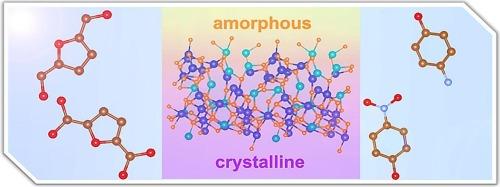通过热诱导非晶化调整MOF衍生物的反应性:4-硝基苯酚高效解毒的协同晶体/非晶异质界面
IF 13.2
1区 工程技术
Q1 ENGINEERING, CHEMICAL
引用次数: 0
摘要
通过选择性硝基还原成有价值的氨基衍生物,对硝基芳香族污染物进行高效解毒的电催化剂的开发在化学增值和环境修复中越来越受到关注。本文中,我们提出了一种结构不完全热解的双金属电催化剂,具有结构模糊的低结晶度域,其中通过相变-近端热解实现的初级核的不规则互连使得4-硝基苯酚(4-NP)的有效电化学加氢。实验验证结果表明,精确控制热解在保持原始骨架结构完整性的同时,产生大量可达的催化活性位点,协同提高加氢效率。此外,系统的DFT计算揭示了晶体/非晶态异质界面增强电催化活性的内在机制。通过精确控制的热非晶化,本工作建立了一种双功能电催化剂设计方法,同时实现选择性生物质增值和持久性有机污染物的解毒。本文章由计算机程序翻译,如有差异,请以英文原文为准。

Tailoring reactivity in MOF derivatives via thermally induced amorphization: Synergistic crystalline/amorphous heterointerfaces for efficient 4-nitrophenol detoxification
The development of electrocatalysts capable of efficient detoxification of nitroaromatic contaminants via selective nitro-group reduction into valuable amino derivatives with high efficiency is gaining increasing interest in both chemical valorization and environmental remediation. Herein, we present an incompletely pyrolyzed bimetallic electrocatalyst with structurally ambiguous low-crystallinity domains, where irregular interconnections of primary nuclei achieved through phase-transition-proximal pyrolysis enable effective electrochemical hydrogenation of 4-nitrophenol (4-NP). Experimental validation results demonstrate that precisely controlled pyrolysis preserves the structural integrity of the pristine framework while generating abundant accessible catalytically-active sites, synergistically boosting hydrogenation efficiency. Further, systematic DFT calculations were conducted to decipher the intrinsic mechanism of the electrocatalytic activity enhancement by crystalline/amorphous heterointerfaces. Through precision-controlled thermal amorphization, this work establishes a dual-functional electrocatalyst design approach that concurrently achieves selective biomass valorization and detoxification of persistent organic pollutants.
求助全文
通过发布文献求助,成功后即可免费获取论文全文。
去求助
来源期刊

Chemical Engineering Journal
工程技术-工程:化工
CiteScore
21.70
自引率
9.30%
发文量
6781
审稿时长
2.4 months
期刊介绍:
The Chemical Engineering Journal is an international research journal that invites contributions of original and novel fundamental research. It aims to provide an international platform for presenting original fundamental research, interpretative reviews, and discussions on new developments in chemical engineering. The journal welcomes papers that describe novel theory and its practical application, as well as those that demonstrate the transfer of techniques from other disciplines. It also welcomes reports on carefully conducted experimental work that is soundly interpreted. The main focus of the journal is on original and rigorous research results that have broad significance. The Catalysis section within the Chemical Engineering Journal focuses specifically on Experimental and Theoretical studies in the fields of heterogeneous catalysis, molecular catalysis, and biocatalysis. These studies have industrial impact on various sectors such as chemicals, energy, materials, foods, healthcare, and environmental protection.
 求助内容:
求助内容: 应助结果提醒方式:
应助结果提醒方式:


